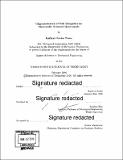Characterization of gait energetics for electrically actuated quadrupeds
Author(s)
Evans, Kathryn Louise, S.M. Massachusetts Institute of Technology
DownloadFull printable version (12.16Mb)
Other Contributors
Massachusetts Institute of Technology. Department of Mechanical Engineering.
Advisor
Sangbae Kim.
Terms of use
Metadata
Show full item recordAbstract
Despite the development of many quadrupedal robots and variety of possible running gaits, relatively little is known on the mechanisms that interplay between gait patterns and efficiency of quadrupedal machines. To gain insight on the energetics of robotic running, this work presents a study of the energetic trends across variations in gait and explores the mechanisms that are responsible for running efficiency for a quadrupedal robot. Motivated by the MIT Cheetah, the study uses a prototypical quadruped model, where DC motors are the main means of actuation, to extract principles for future control and design. This represents the first such study across gaits for robotic quadrupeds in the design paradigm of the MIT Cheetah. With the prototype model, we have found that it is energetically optimal to tend towards impulsive ground reaction forces on rigid terrain. Adding compliance at the contact interface lowers the cost of transport and increases the optimal duty ratio. In the optimal gaits, the total cost of transport is dominated by the cost of joule heating in the motors, and positive mechanical work only accounts for only 3-8% of the total cost. Analysis of trotting, pronking, bounding and galloping gaits reveals trotting to be the most energetically efficient gait across Froude numbers from 0.2 to 45. This trend represents a significant difference from animals, which transition to a gallop at a Froude number between 2 to 3.
Description
Thesis: S.M., Massachusetts Institute of Technology, Department of Mechanical Engineering, 2016. Cataloged from PDF version of thesis. Includes bibliographical references (pages 123-131).
Date issued
2016Department
Massachusetts Institute of Technology. Department of Mechanical EngineeringPublisher
Massachusetts Institute of Technology
Keywords
Mechanical Engineering.